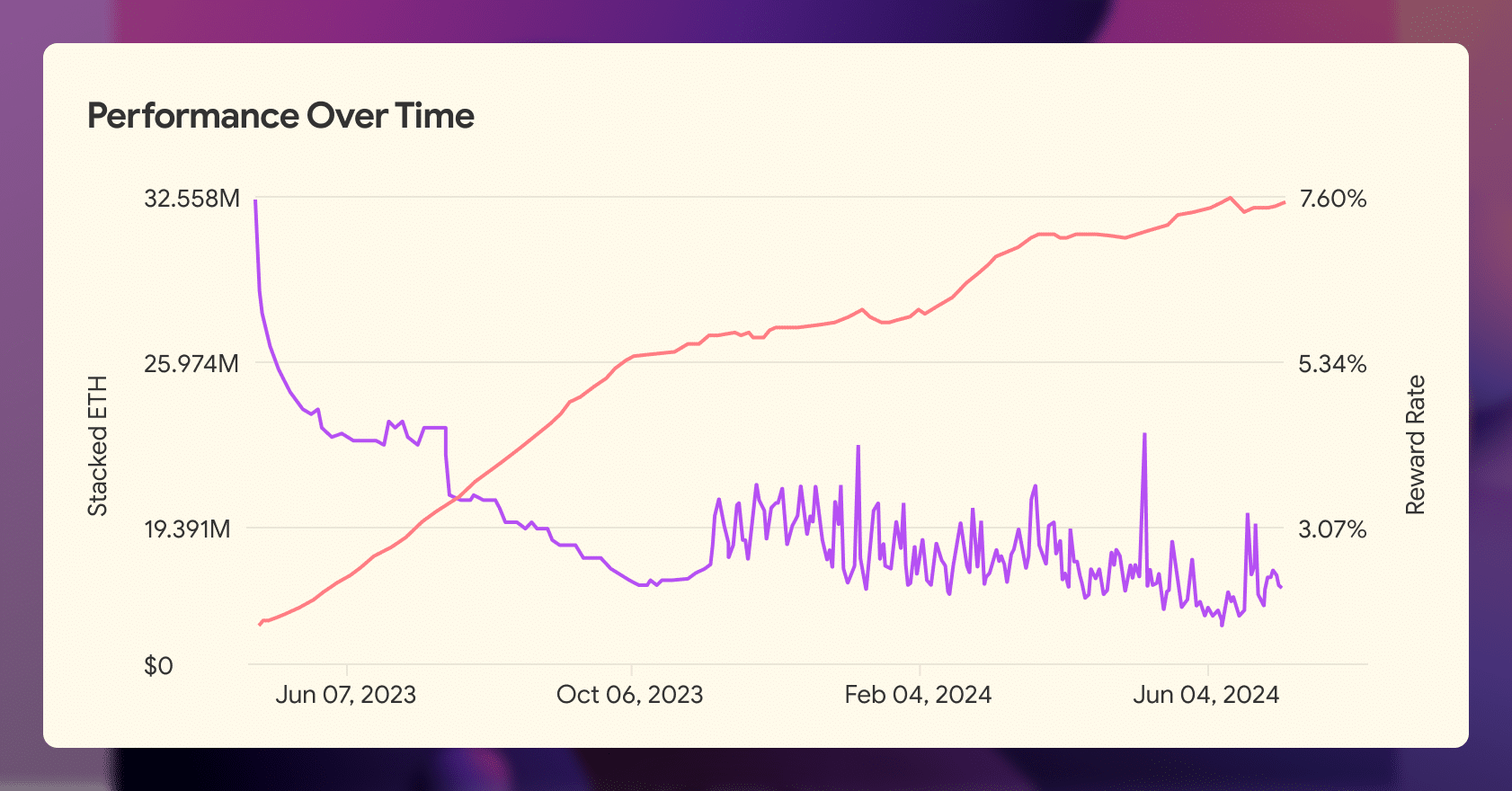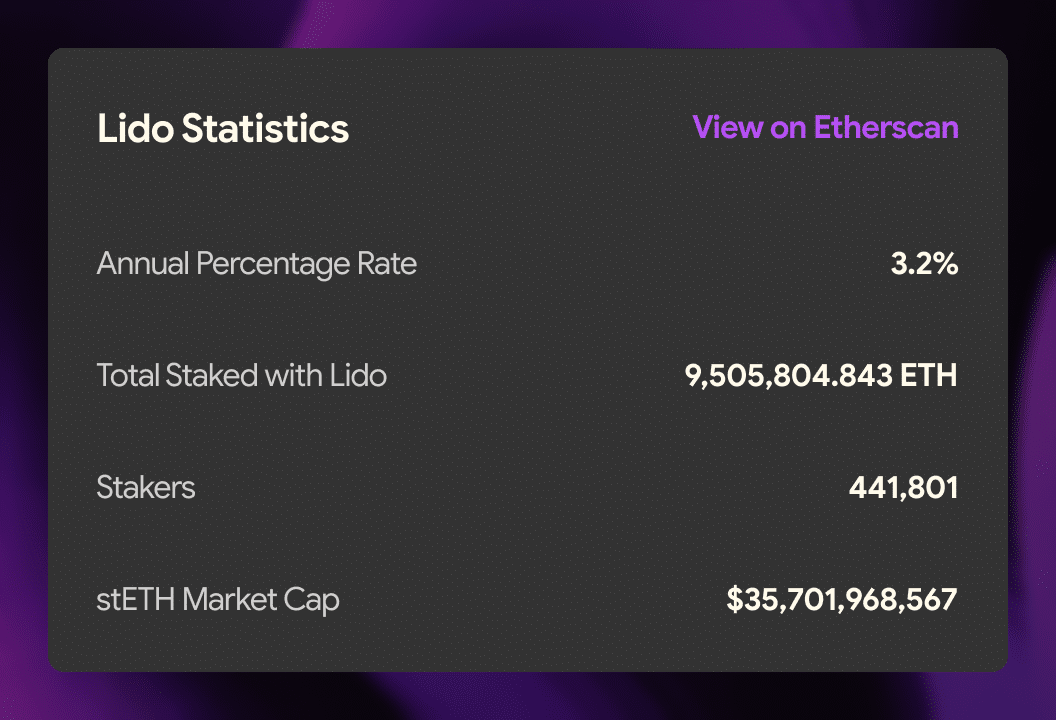
The Power of Compounding Staking Rewards
“Compound interest is the eighth wonder of the world. He who understands it, earns it. He who doesn't, pays it,” - Albert Einstein
Finding ways to generate extra returns in the crypto landscape can be quite challenging. You can leverage trade, yield farm, or receive airdrops, but all these require extra time and knowledge.
Fortunately, you can passively earn additional rewards just by compounding your staked balance. This can be achieved without taking on more risk.
In this article, you’ll learn about:
 For instance, if you invest $1,000 in a bank’s high-yield savings account with an annual interest rate of 5%, you earn $50 in the first year. In total, your balance has grown to $1,050. In the second year, the interest is calculated on the new total of $1,050, leading to $52.50 in earnings, and so on. Over time, the growth of your investment accelerates.
For instance, if you invest $1,000 in a bank’s high-yield savings account with an annual interest rate of 5%, you earn $50 in the first year. In total, your balance has grown to $1,050. In the second year, the interest is calculated on the new total of $1,050, leading to $52.50 in earnings, and so on. Over time, the growth of your investment accelerates.
 For crypto staking, rewards may compound, but the payouts can fall on odd-numbered days due to the processes of each network. Depending on the platform you’re staking on as well, rewards may be paid differently.
Lido Finance, the highly popular liquid staking and decentralized finance (DeFi) platform, gives out rewards daily for ETH staking.
Meanwhile, Coinbase staking hands out ETH staking rewards every 3 days. While the annual returns would be minuscule at the start, the difference becomes bigger over a long time horizon.
For crypto staking, rewards may compound, but the payouts can fall on odd-numbered days due to the processes of each network. Depending on the platform you’re staking on as well, rewards may be paid differently.
Lido Finance, the highly popular liquid staking and decentralized finance (DeFi) platform, gives out rewards daily for ETH staking.
Meanwhile, Coinbase staking hands out ETH staking rewards every 3 days. While the annual returns would be minuscule at the start, the difference becomes bigger over a long time horizon.

 Lido Finance gives out ETH liquid staking rewards daily and compounds at the same rate.
Lido Finance gives out ETH liquid staking rewards daily and compounds at the same rate.
- Compound interest
- Compounded staking returns versus traditional interest
- How to compound staking rewards
- How to take advantage
What is Compound Interest?
Compound interest is interest earned on an investment that is reinvested. Essentially, it's "interest on interest." The power of compounding lies in its exponential growth potential, making it a powerful tool for long-term investments. For instance, if you invest $1,000 in a bank’s high-yield savings account with an annual interest rate of 5%, you earn $50 in the first year. In total, your balance has grown to $1,050. In the second year, the interest is calculated on the new total of $1,050, leading to $52.50 in earnings, and so on. Over time, the growth of your investment accelerates.
For instance, if you invest $1,000 in a bank’s high-yield savings account with an annual interest rate of 5%, you earn $50 in the first year. In total, your balance has grown to $1,050. In the second year, the interest is calculated on the new total of $1,050, leading to $52.50 in earnings, and so on. Over time, the growth of your investment accelerates.
How Does Staking Compound?
In the crypto market, staking involves locking up your assets in a network to help maintain its operations in return for rewards. Staking is the consensus mechanism for Proof-of-Stake (PoS) and Delegated-Proof-of-Stake (DPoS) networks such as Ethereum and Solana, respectively. Staking compounding refers to reinvesting those staking rewards to earn additional yield over time. For example, if you stake 10 ETH and earn 5% annually, you'll have 10.5 ETH at the end of the first year. If you reinvest those rewards, the next year's rewards are computed on the 10.5 ETH, not just the initial 10 ETH. By now, you may have noticed how this sounds exactly like traditional finance’s compound interest terminology. But there are some key differences, as explained in the next section.How Staking Differs from Traditional Finance
While the mathematical principle of compounding remains the same in both traditional finance and staking, the mechanisms differ significantly.Compound Frequency
Traditional investments typically compound annually, quarterly, or monthly. Ideally, you get a daily interest payout as the more frequently you compound, the higher the annual return. Here’s a table to show the difference, given a $100 investment at 5% annual interest rate: For crypto staking, rewards may compound, but the payouts can fall on odd-numbered days due to the processes of each network. Depending on the platform you’re staking on as well, rewards may be paid differently.
Lido Finance, the highly popular liquid staking and decentralized finance (DeFi) platform, gives out rewards daily for ETH staking.
Meanwhile, Coinbase staking hands out ETH staking rewards every 3 days. While the annual returns would be minuscule at the start, the difference becomes bigger over a long time horizon.
For crypto staking, rewards may compound, but the payouts can fall on odd-numbered days due to the processes of each network. Depending on the platform you’re staking on as well, rewards may be paid differently.
Lido Finance, the highly popular liquid staking and decentralized finance (DeFi) platform, gives out rewards daily for ETH staking.
Meanwhile, Coinbase staking hands out ETH staking rewards every 3 days. While the annual returns would be minuscule at the start, the difference becomes bigger over a long time horizon.
Interest Rate Volatility
Cryptocurrencies move more wildly than traditional assets, not just in terms of asset prices but also with their stated returns. If you’re investing in a bank time deposit or savings account, you are promised an annual interest rate. The financial institution cannot change this stated rate. If you’re investing in equities, then the company is more likely to maintain a stable dividend policy to keep shareholders satisfied. Crypto staking rewards decline over time as the network gets bigger and more stakers join the system. Ethereum, the largest and most stable blockchain to stake on, has offered fewer rewards. Staking rewards fell from nearly 8% in June 2023 to below 4% as of writing.
How to Compound Staking Rewards
Depending on which network, staking method, and platform you’re using, staking rewards can compound in a few ways:Manual Compounding
This applies to instances where there is a maximum amount that you can stake in a single account. To become a solo staker on Ethereum, you need 32 ETH. This is also the maximum you can stake per validator. Thus the staking rewards arrive in another account. For your staking rewards to begin compounding, you would have to transfer them to another DeFi platform. However, this may improve with Ethereum Pectra. The upcoming network upgrade removes the 32 ETH cap and allows solo stakers to compound staking rewards.Automatic Compounding
Some staking platforms or wallets automatically reinvest your rewards. For example, if a platform offers daily rewards, those rewards are automatically added to your staked amount, and future rewards are calculated based on the new total. Lido Finance gives out ETH liquid staking rewards daily and compounds at the same rate.
Lido Finance gives out ETH liquid staking rewards daily and compounds at the same rate.
How to Leverage Staking Compounding
You can leverage staking compounding in several ways to maximize earnings.Choose Platforms with Automatic Compounding
Opt for staking platforms that offer automatic compounding of rewards. This ensures that your rewards are consistently reinvested without requiring manual intervention. Some wallets also come with auto-compounding features. Wallets like Phantom Wallet for Solana support compounding.Regularly Reinvest Rewards
If automatic compounding is not available, make it a habit to regularly claim and restake your rewards. This can help you maximize the compounding effect. You can even take advantage of restaking platforms. This new innovation empowers you to stake and earn rewards using your original staked crypto.Take Advantage of the Eighth World Wonder
In conclusion, understanding the power of compounding in staking rewards can significantly enhance your earnings in the crypto market. By choosing the right platforms and strategies, investors can maximize their returns and leverage the exponential growth potential of compounded staking rewards.The content of solostakers.com is for informational purposes only and should not be considered financial advice. It represents the personal views and opinions of the author(s) and is not endorsed by any financial institution or regulatory body. Cryptocurrency and staking investments carry inherent risks and readers should conduct their own research and consult with a financial professional before making any investment decisions. The owner and author(s) of solostakers.com will not be liable for any losses, damages, or consequences arising from the use of the information on this site. By accessing solostakers.com, you agree to bear full responsibility for your investment decisions.

Sign Up To Our Newsletter
Curious about deepening your staking knowledge? Explore related content on Solostakers.com and join our community of enthusiasts. Together, we can shape the future of PoS staking.
